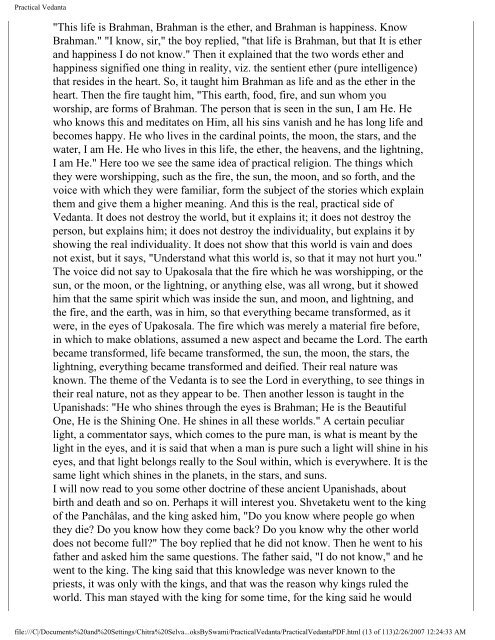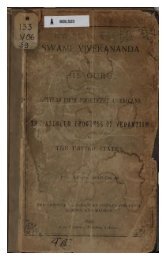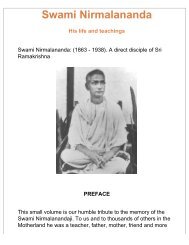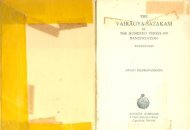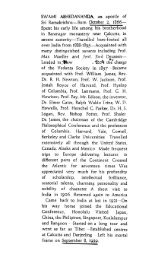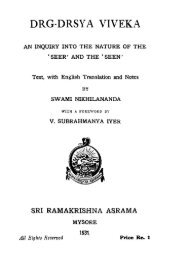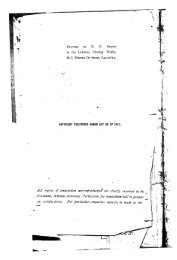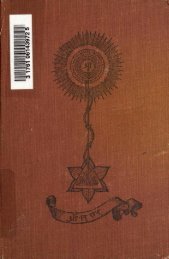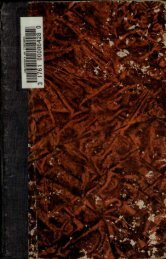<strong>Practical</strong> <strong>Vedanta</strong>the Lord, so is the West, so is the South, so is the North. The four cardinal pointsare the four parts of Brahman. Fire will also teach you something of Brahman."Fire was a great symbol in those days, and every student had to procure fire andmake offerings. So on the following day, Satyakama started for his Guru's house,and when in the evening he had performed his oblation, and worshipped at thefire, and was sitting near it, he heard a voice come from the fire, "O Satyakama.""Speak, Lord," said Satyakama. (Perhaps you may remember a very similar storyin the Old Testament, how Samuel heard a mysterious voice.) "O Satyakama, I amcome to teach you a little of Brahman. This earth is a portion of that Brahman. Thesky and the heaven are portions of It. The ocean is a part of that Brahman." Thenthe fire said that a certain bird would also teach him something. Satyakamacontinued his journey and on the next day when he had performed his eveningsacrifice a swan came to him and said, "I will teach you something aboutBrahman. This fire which you worship, O Satyakama, is a part of that Brahman.The sun is a part, the moon is a part, the lightning is a part of that Brahman. A birdcalled Madgu will tell you more about it." The next evening that bird came, and asimilar voice was heard by Satyakama, "I will tell you something about Brahman.Breath is a part of Brahman, sight is a part, hearing is a part, the mind is a part."Then the boy arrived at his teacher's place and presented himself before him withdue reverence. No sooner had the teacher seen this disciple than he remarked:"Satyakama, thy face shines like that of a knower of Brahman! Who then hastaught thee?" "Beings other than men," replied Satyakama. "But I wish that youshould teach me, sir. For I have heard from men like you that knowledge which islearnt from a Guru alone leads to the supreme good." Then the sage taught him thesame knowledge which he had received from the gods. "And nothing was left out,yea, nothing was left out."Now, apart from the allegories of what the bull, the fire, and the birds taught, wesee the tendency of the thought and the direction in which it was going in thosedays. The great idea of which we here see the germ is that all these voices areinside ourselves. As we understand these truths better, we find that the voice is inour own heart, and the student understood that all the time he was hearing thetruth; but his explanation was not correct. He was interpreting the voice as comingfrom the external world, while all the time, it was within him. The second idea thatwe get is that of making the knowledge of the Brahman practical. The world isalways seeking the practical possibilities of religion, and we find in these storieshow it was becoming more and more practical every day. The truth was shownthrough everything with which the students were familiar. The fire they wereworshipping was Brahman, the earth was a part of Brahman, and so on.The next story belongs to Upakosala Kâmalâyana, a disciple of this Satyakama,who went to be taught by him and dwelt with him for some time. Now Satyakamawent away on a journey, and the student became very downhearted; and when theteacher's wife came and asked him why he was not eating, the boy said, "I am toounhappy to eat." Then a voice came from the fire he was worshipping, sayingfile:///C|/Documents%20and%20Settings/Chitra%20Selva...oksBySwami/<strong>Practical</strong><strong>Vedanta</strong>/<strong>Practical</strong><strong>Vedanta</strong>PDF.html (12 of 113)2/26/2007 12:24:33 AM
<strong>Practical</strong> <strong>Vedanta</strong>"This life is Brahman, Brahman is the ether, and Brahman is happiness. KnowBrahman." "I know, sir," the boy replied, "that life is Brahman, but that It is etherand happiness I do not know." Then it explained that the two words ether andhappiness signified one thing in reality, viz. the sentient ether (pure intelligence)that resides in the heart. So, it taught him Brahman as life and as the ether in theheart. Then the fire taught him, "This earth, food, fire, and sun whom youworship, are forms of Brahman. The person that is seen in the sun, I am He. Hewho knows this and meditates on Him, all his sins vanish and he has long life andbecomes happy. He who lives in the cardinal points, the moon, the stars, and thewater, I am He. He who lives in this life, the ether, the heavens, and the lightning,I am He." Here too we see the same idea of practical religion. The things whichthey were worshipping, such as the fire, the sun, the moon, and so forth, and thevoice with which they were familiar, form the subject of the stories which explainthem and give them a higher meaning. And this is the real, practical side of<strong>Vedanta</strong>. It does not destroy the world, but it explains it; it does not destroy theperson, but explains him; it does not destroy the individuality, but explains it byshowing the real individuality. It does not show that this world is vain and doesnot exist, but it says, "Understand what this world is, so that it may not hurt you."The voice did not say to Upakosala that the fire which he was worshipping, or thesun, or the moon, or the lightning, or anything else, was all wrong, but it showedhim that the same spirit which was inside the sun, and moon, and lightning, andthe fire, and the earth, was in him, so that everything became transformed, as itwere, in the eyes of Upakosala. The fire which was merely a material fire before,in which to make oblations, assumed a new aspect and became the Lord. The earthbecame transformed, life became transformed, the sun, the moon, the stars, thelightning, everything became transformed and deified. Their real nature wasknown. The theme of the <strong>Vedanta</strong> is to see the Lord in everything, to see things intheir real nature, not as they appear to be. Then another lesson is taught in theUpanishads: "He who shines through the eyes is Brahman; He is the BeautifulOne, He is the Shining One. He shines in all these worlds." A certain peculiarlight, a commentator says, which comes to the pure man, is what is meant by thelight in the eyes, and it is said that when a man is pure such a light will shine in hiseyes, and that light belongs really to the Soul within, which is everywhere. It is thesame light which shines in the planets, in the stars, and suns.I will now read to you some other doctrine of these ancient Upanishads, aboutbirth and death and so on. Perhaps it will interest you. Shvetaketu went to the kingof the Panchâlas, and the king asked him, "Do you know where people go whenthey die? Do you know how they come back? Do you know why the other worlddoes not become full?" The boy replied that he did not know. Then he went to hisfather and asked him the same questions. The father said, "I do not know," and hewent to the king. The king said that this knowledge was never known to thepriests, it was only with the kings, and that was the reason why kings ruled theworld. This man stayed with the king for some time, for the king said he wouldfile:///C|/Documents%20and%20Settings/Chitra%20Selva...oksBySwami/<strong>Practical</strong><strong>Vedanta</strong>/<strong>Practical</strong><strong>Vedanta</strong>PDF.html (13 of 113)2/26/2007 12:24:33 AM
- Page 1 and 2: Practical VedantaPractical VedantaP
- Page 3 and 4: Practical Vedantaworld. If I am a s
- Page 5 and 6: Practical Vedantadifference is only
- Page 7 and 8: Practical VedantaThe ideal of faith
- Page 9 and 10: Practical Vedantamoment of our live
- Page 11: Practical Vedantaof the Christs and
- Page 15 and 16: Practical Vedantadark fifteen days,
- Page 17 and 18: Practical Vedantalife. This is the
- Page 19 and 20: Practical Vedantaeverything would b
- Page 21 and 22: Practical Vedantait is only through
- Page 23 and 24: Practical Vedantawhich is that subt
- Page 25 and 26: Practical Vedantanoumenon and pheno
- Page 27 and 28: Practical Vedantato which is the be
- Page 29 and 30: Practical VedantaAbsolute.The finit
- Page 31 and 32: Practical Vedantawhich is not the q
- Page 33 and 34: Practical Vedantaexperience that th
- Page 35 and 36: Practical Vedantafulfilled. The Jiv
- Page 37 and 38: Practical Vedantabetween the pure r
- Page 39 and 40: Practical Vedantacome out straight.
- Page 41 and 42: Practical Vedantawar with one anoth
- Page 43 and 44: Practical Vedantanobody could under
- Page 45 and 46: Practical VedantaMy idea, therefore
- Page 47 and 48: Practical Vedantathe same methods.
- Page 49 and 50: Practical Vedantavarious minds, all
- Page 51 and 52: Practical Vedantabrotherhood; but t
- Page 53 and 54: Practical Vedantabrotherhood, but w
- Page 55 and 56: Practical Vedantawe all go with ves
- Page 57 and 58: Practical Vedantareason. What can y
- Page 59 and 60: Practical Vedantabeen preached in t
- Page 61 and 62: Practical Vedantathe husband kisses
- Page 63 and 64:
Practical Vedantaof the knowledge a
- Page 65 and 66:
Practical Vedantafor those who only
- Page 67 and 68:
Practical Vedantasun exists because
- Page 69 and 70:
Practical Vedantaof death was pleas
- Page 71 and 72:
Practical VedantaGod. We must learn
- Page 73 and 74:
Practical Vedantaa plague comes, it
- Page 75 and 76:
Practical VedantaAtman? "As with a
- Page 77 and 78:
Practical Vedantathat immortal One,
- Page 79 and 80:
Practical Vedantaand the third egoi
- Page 81 and 82:
Practical VedantaWitness of the uni
- Page 83 and 84:
Practical VedantaPractical Vedanta1
- Page 85 and 86:
Practical Vedantaeternal ; every ot
- Page 87 and 88:
Practical Vedantafaculty, Buddhi, w
- Page 89 and 90:
Practical VedantaPractical Vedanta1
- Page 91 and 92:
Practical Vedantastepping-stone to
- Page 93 and 94:
Practical Vedantarecognition? Findi
- Page 95 and 96:
Practical Vedantasentient." This is
- Page 97 and 98:
Practical Vedantaessentially differ
- Page 99 and 100:
Practical Vedantaexistence is limit
- Page 101 and 102:
Practical Vedantalive, for I am lif
- Page 103 and 104:
Practical Vedantasee from Kapila's
- Page 105 and 106:
Practical Vedantalimitation, but th
- Page 107 and 108:
Practical Vedantaperfect, infinite,
- Page 109 and 110:
Practical Vedantaindividuality, of
- Page 111 and 112:
Practical Vedantarepeat [something]
- Page 113:
Practical Vedantaperson who dies in


